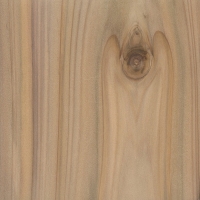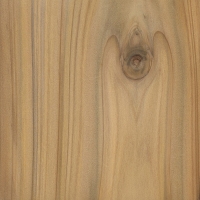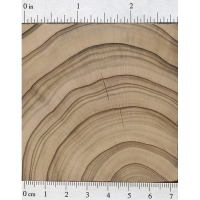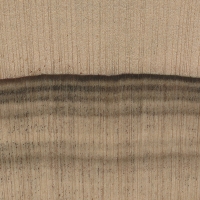 |
Common Name(s): Leyland Cypress Scientific Name: Cupressus x leylandii Distribution: Originated as a hybrid in Wales, UK; no natural range Tree Size: 65-100 ft (20-30 m) tall, 2-3 ft (.6-1 m) trunk diameter Average Dried Weight: 31 lbs/ft3 (500 kg/m3) Specific Gravity (Basic, 12% MC): .41, .50 Janka Hardness: 430 lbf (1,890 N) Modulus of Rupture: 12,000 lbf/in2 (82.7 MPa) Elastic Modulus: 989,000 lbf/in2 (6.82 GPa) Crushing Strength: 5,510 lbf/in2 (38.0 MPa) Shrinkage: Radial: 2.8%, Tangential: 6.7%, Volumetric: 9.6%, T/R Ratio: 2.4 |
Color/Appearance: Heartwood is a pale yellowish or reddish brown. Narrow sapwood is paler and usually clearly demarcated from the heartwood.
Grain/Texture: Grain is usually straight, though small knots are sometimes present, creating a more irregular grain pattern. Fine, uniform texture with a good natural luster.
Endgrain: Resin canals absent; earlywood to latewood transition gradual, color contrast low to medium; tracheid diameter small to medium; parenchyma diffuse.
Rot Resistance: Rated as moderately durable; mixed resistance to insect attack.
Workability: Overall easy to work with hand and machine tools, though areas around knots can be problematic. Reportedly difficult to steam bend. Glues, stains, and finishes well.
Odor: Most cypresses in the Cupressus genus have a distinct, fragrant scent.
Allergies/Toxicity: Although severe reactions are quite uncommon, Leyland Cypress has been reported to cause skin irritation. See the articles Wood Allergies and Toxicity and Wood Dust Safety for more information.
Pricing/Availability: Not commonly seen for sale in lumber form, most cultivated trees are used for nursery stock.
Sustainability: This wood species is not listed in the CITES Appendices or on the IUCN Red List of Threatened Species. (Since it’s only a hybrid with no natural range, it’s unsuitable to be considered for conservation.)
Common Uses: Utility lumber, fence posts, musical instruments (flamenco guitars), furniture, boatbuilding, and turned objects.
Comments: What began as an accidental hybridization in the mid 1800s in Wales has grown into a lucrative (and sometimes despised) nursery stock tree. Leyland Cypress is a hybrid between Monterey Cypress (Cupressus macrocarpa) and Alaskan Yellow Cedar (Cupressus nootkatensis). It’s a fast-growing, adaptive tree that’s commonly used in the United Kingdom for hedges—though its fast growth rate means that it has caused numerous disputes between neighbors over thickly shadowing trees along property lines.
- Alaskan Yellow Cedar (Cupressus nootkatensis)
- Gowen Cypress (Cupressus goveniana)
- Mediterranean Cypress (Cupressus sempervirens)
- Mexican Cypress (Cupressus lusitanica)
- Monterey Cypress (Cupressus macrocarpa)
None available.
 |
 |
 |
 |


Personal observations, having taken an interest in this tree for nearly half a century: Best felled in winter, else thick sap can foul chainsaw. Don’t rush to mill, let it season first Shoots ‘identify’ as either leading shoots or branches, a branch cutting can sometimes propagate to create a tree that thinks it’s a branch, with a swept bole Really strong understory tree, will grow slowly but persistantly under a canopy of deciduous trees Lower branches are reluctant to die, resulting in fewer dead knots than other species Much neglected as a timber tree, great promise where good utility and… Read more »
Thanks for tip #1. In my heavy, winter wet soil, they love to tip over. Also, those upward angled branches kinda hate snow and ice….
Leyland Cypress is worth acquiring if you come across a big log. The wood turns nicely, has interesting grain patterns and polishes to a soft luster. I believe I read that it has been approved as structural timber in New Zealand or Australia. Makes sense, as it is light, strong and rot-resistant. Here’s a Leyland bowl from a storm-downed tree.
I am curious about Leyland Cypress. Once topped (about 20 feet) how will it increase in higth or will fill in and grow outward?
Yes it will increase in height, but will continue to fill out. Its likely to continue growing in height for the rest of your life or it’s.
Do you have or know where I can get pecky sinker cypress wood from? Thanks
And despite the folklore, once dried it burns well.
I agree….although outside uncovered it takes 24 months to be of any use as fuel